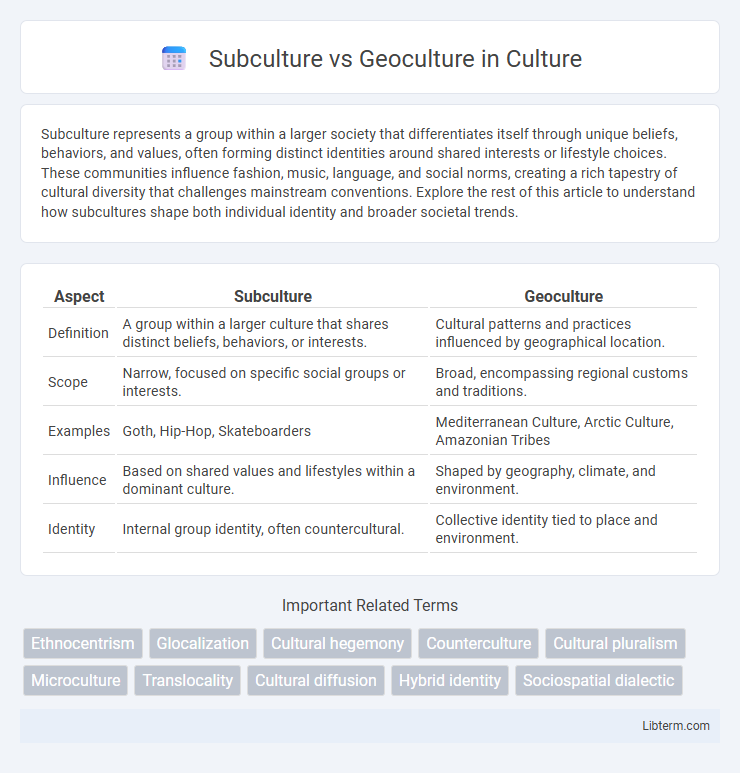Subculture represents a group within a larger society that differentiates itself through unique beliefs, behaviors, and values, often forming distinct identities around shared interests or lifestyle choices. These communities influence fashion, music, language, and social norms, creating a rich tapestry of cultural diversity that challenges mainstream conventions. Explore the rest of this article to understand how subcultures shape both individual identity and broader societal trends.
Table of Comparison
| Aspect | Subculture | Geoculture |
|---|---|---|
| Definition | A group within a larger culture that shares distinct beliefs, behaviors, or interests. | Cultural patterns and practices influenced by geographical location. |
| Scope | Narrow, focused on specific social groups or interests. | Broad, encompassing regional customs and traditions. |
| Examples | Goth, Hip-Hop, Skateboarders | Mediterranean Culture, Arctic Culture, Amazonian Tribes |
| Influence | Based on shared values and lifestyles within a dominant culture. | Shaped by geography, climate, and environment. |
| Identity | Internal group identity, often countercultural. | Collective identity tied to place and environment. |
Understanding Subculture and Geoculture
Subculture refers to a distinct group within a larger culture that shares unique beliefs, values, and behaviors, often differentiating itself through language, customs, and interests. Geoculture encompasses the cultural characteristics and practices shaped by geographic location, including regional traditions, climate-influenced lifestyles, and local social norms. Understanding subculture involves analyzing group identity and internal diversity, while understanding geoculture requires examining how physical environment and spatial factors influence cultural development.
Origins and Development of Subcultures
Subcultures originate from distinct social groups that develop unique norms, values, and symbols in response to broader cultural or societal influences, often as expressions of identity or resistance. Unlike geocultures that are defined by geographic and environmental factors influencing cultural practices, subcultures form through shared interests, lifestyles, or ideologies within diverse communities regardless of location. The development of subcultures is driven by social interaction, media influence, and generational shifts, creating dynamic, evolving cultural landscapes.
What Defines a Geoculture?
A geoculture is defined by the distinct cultural traits, values, and practices shared by people within a specific geographic region, influenced by the environment, history, and socio-economic factors unique to that area. Unlike subcultures, which can exist within broader societies regardless of location, geocultures are deeply tied to place and often include language dialects, traditional customs, culinary habits, and social norms shaped by regional landscapes. This geographical rootedness creates a collective identity that distinguishes one geoculture from another on a global scale.
Key Differences Between Subculture and Geoculture
Subculture refers to a group within a larger culture that differentiates itself through unique beliefs, values, and behaviors often based on shared interests or experiences. Geoculture emphasizes cultural characteristics shaped by geographic regions, including language, traditions, and environmental influences that unify people within a specific location. Key differences include the basis of identity, where subculture centers on social or ideological distinctions, and geoculture relies on physical and spatial factors contributing to cultural diversity.
Social Influence of Subcultures
Subcultures exert significant social influence by shaping group identities, norms, and behaviors that distinguish members from the dominant culture. These distinctive value systems and practices foster community cohesion and provide alternative frameworks for social interaction, often challenging mainstream societal expectations. In contrast, geoculture pertains to regional cultural traits influenced by geography, focusing more on shared environmental factors than on identity-based social differentiation.
Geoculture’s Impact on Global Perspectives
Geoculture shapes global perspectives by integrating local cultural practices with geographic and environmental contexts, fostering a sense of place-based identity that transcends national boundaries. Unlike subcultures, which evolve within specific social groups, geocultures influence broader cultural diffusion and intercultural exchange through shared landscapes, traditions, and natural resources. This impact promotes sustainable development and international cooperation by highlighting how geography and culture collectively inform global values and worldviews.
Intersection of Subculture and Geoculture
The intersection of subculture and geoculture highlights how localized cultural identities influence collective behaviors within specific geographic regions. Subcultures often emerge from distinct geocultural contexts, blending traditions, language, and social norms unique to an area. This fusion shapes community values and expressions, reflecting both micro-level social dynamics and macro-level regional characteristics.
Subculture vs Geoculture in Modern Society
Subculture and geoculture represent distinct frameworks for understanding social identity, with subculture emphasizing shared values, beliefs, and practices within groups that often transcend geographical boundaries, while geoculture focuses on cultural traits deeply rooted in specific locations and environments. In modern society, subcultures such as digital communities and lifestyle movements challenge traditional geocultural boundaries by creating identity formations that are fluid and global rather than fixed and regional. The rise of social media platforms amplifies subcultural visibility, diminishing the dominance of geoculture in shaping individual and collective identities, and promoting a dynamic interplay between local traditions and global influences.
Case Studies: Examples of Subcultures and Geocultures
Case studies reveal that subcultures, such as the goth community in urban areas, exhibit distinct fashion, music, and values within broader societies, while geocultures like Mediterranean cultures encompass shared traditions, cuisine, and social behaviors tied to specific geographic regions. The Japanese anime fandom illustrates a subculture with global reach but localized adaptations, contrasting with the Sami geoculture, which reflects indigenous identity and practices concentrated in parts of Scandinavia. These examples highlight how subcultures form through social groups with unique identities, whereas geocultures derive from environmental and historical contexts shaping collective cultural traits.
The Future of Cultural Identity: Subculture and Geoculture
The future of cultural identity is increasingly shaped by the interplay between subculture and geoculture, where localized practices and global influences converge to create hybrid cultural expressions. Subcultures foster distinct social identities through shared interests and values, while geoculture grounds cultural identity in geographical and environmental contexts, driving unique regional characteristics. Emerging trends highlight digital connectivity as a critical factor enabling subcultures to transcend geographic boundaries, blending with geocultural elements to redefine cultural identity in a globalized world.
Subculture Infographic

 libterm.com
libterm.com